When I Work is a popular employee scheduling software that offers time and attendance features as an add-on. Intuitive and offering a mobile app and by-user pricing, it’s a good choice for growing businesses with multiple locations. However, it may not be the best for all. Seasonal companies, single-location businesses with many employees, and those with greater compliance needs may want to consider other options.
To find the best When I Work alternatives, we evaluated 19 providers and narrowed it down to the top six:
- Homebase: Best overall When I Work alternative
- Deputy: Best staffing forecasting tools
- 7shifts: Best for restaurants
- Sling: Best budget-friendly alternative
- SocialSchedules: Best for companies in highly regulated industries
- ZoomShift: Best for seasonal businesses
Top When I Work Competitors Compared
Homebase: Best Overall When I Work Alternative

Pros
- Easy to set up and navigate
- Free plan for one-location businesses with up to 20 employees
- Time clock apps included in free plan
- Feature-rich platform (comes with job postings, applicant tracking, time tracking, and staff scheduling + a payroll add-on)
Cons
- Advanced scheduling tools (such as shift swapping) reserved in higher tiers
- Free plan only comes with email support; live chat and phone assistance included in paid packages
- Mobile app glitches; complaints about login issues
Overview
Who should use it:
Homebase ranked number 1 in our free employee scheduling software, top time and attendance system, and best employee scheduling software guides because of its comprehensive scheduling, time tracking, and payroll features that small business owners find convenient and affordable. Employers can quickly and easily build their workers’ schedules in just a few clicks and share them with the team in minutes using the Homebase mobile app.
Why we like it:
What makes Homebase different from When I Work and some of the other providers in this guide is its free scheduling and time tracking plan for businesses with a single location (with up to 20 employees). It also has a feature-rich platform that comes with payroll, job posting, and hiring tools. This saves you time and money from managing separate systems to recruit, onboard, and pay employees.
- Free trial: 14 days
- Free plan:
- Basic: $0 for single-location businesses with up to 20 employees
- Paid plans:
- Essentials: $24.95 per location, per month ($20 per location, per month if billed annually*); includes unlimited employees
- Plus: $59.95 per location, per month ($48 per location, per month if billed annually*)
- All-in-one: $99.95 per location, per month ($80 per location, per month if billed annually)
- Monthly minimum spend: None
- Add-on tools:
- Payroll: $39 base fee + $6 per employee, per month
- Job post boosts: Starts at $79 per job post
- API for Integrations: Call for a quote; included free in the All-in-one plan
- HR Pro Advisors: Call for a quote; included free in the All-in-one plan
*Annual plans require a lump sum and upfront payment of all fees.
- Unlimited scheduling: Unlike When I Work (as well as several When I Work alternatives on this list), Homebase doesn’t charge per employee. You can create as many work shifts as you want and need. Plus, its paid plans allow you to have as many employees in one location as you like for a reasonable fee.
- Scheduling tools: Homebase has a drag-and-drop schedule builder with autoscheduling tools. It supports shift swap requests and sends out automated alerts. Homebase also lets you send shift reminders via text messages.
- Labor and schedule reporting: Homebase has a wide range of customizable reports that can help you gain insight into work shifts, labor expenses and percentages, attendance-related performance, and sales (if synced with a POS). Although When I Work lets you create custom reports, the options are more limited.
- Compliance tools: With Homebase, you automatically get the standard breaks and overtime settings for the state where your business operates. The software also captures and stores schedule edit histories, including previously run time sheets and reports, for either 90 days or four years (although, SocialSchedules saves this data for seven years, while the others we reviewed don’t list how long). This makes it easy for you to comply with the Fair Labor Standards Act (FLSA) and recordkeeping requirements.
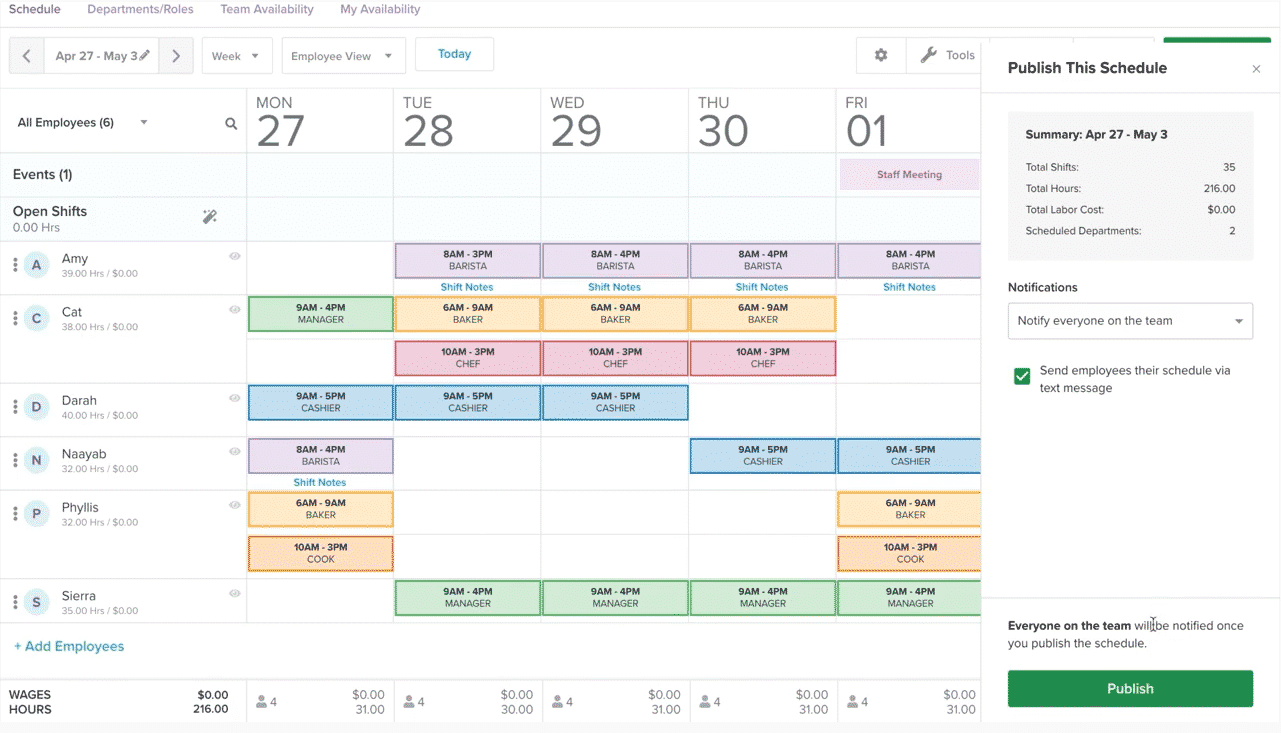
Homebase’s schedule offers multiple views. (Source: Homebase)
Deputy: Best Staffing Forecasting Tools

Pros
- With a free tier
- Affordable plans with separate packages for time tracking and employee scheduling
- Unlimited 24/7 customer support
- Low-cost Flexi plan offered to those who schedule less than half of employees in any given week
- Basic HR tools to post jobs, onboard employees, and run staff surveys
Cons
- Unlimited shifts, autoscheduling, and schedule templates available only in paid plans
- Monthly plans with minimum spend requirement (except for the Flexi Weekly plan)
- Extra fees for HR tools
- Free plan only for US-based businesses
Overview
Who should use it:
Deputy is a good scheduling option for businesses with shared hourly and shift workers across different locations. You can either manually create shifts that assign employees to different work sites and departments or use its artificial intelligence (AI)-powered scheduler to build demand-based and labor-optimized work shifts. And, if your employees request to swap shifts online, the system automatically transfers their department and worksite data after the requests have been approved.
Why we like it:
With autoscheduling tools that use AI, Deputy can create labor demand forecasts with schedule suggestions you can customize. It also lets you set a limit on the number of hours team members can work per day or week, helping you prevent employee burnout and stress from working long hours.
Like When I Work, Deputy has a highly rated mobile app and lets you choose a plan with either only scheduling features or with additional time tracking tools. If you only need time clocks to capture and manage employee attendance, Deputy has a separate plan for that, too. This is unique among the When I Work competitors on our list. However, it requires a minimum monthly spend of $25. For a scheduling software without any minimum spend requirements, consider the other providers in this guide.
- Free trial: 31 days
- Free plan:
- Starter: $0 for 100 shifts and timesheets per month; for US-based businesses only
- Paid plans:
- Premium: $6 per employee, per month ($5 per employee, per month if billed annually*)
- Enterprise: Call for a quote
- Flexi Weekly: $2.50 per active employee weekly + 50 cents per inactive employee weekly; this is ideal for businesses that schedule less than half of employees in any given week
- Other products:
- Standalone scheduling: $4.50 per employee, per month
- Standalone time and attendance: $4.50 per employee, per month
- Monthly minimum spend: $25 for all standalone and paid plans (except Flexi Weekly)
- Add-on tools:
*Annual plans require a lump sum and upfront payment of all fees.
- Forecasting: Deputy provides tools that let you predict staffing needs based on trends in sales, deliveries, appointments/reservations, and other signals you can set (such as weather and traffic data). It can also use the forecasting tools when automatically creating a schedule; most software just gives you an analysis.
- Employee communications: Read notifications tell you who saw your posted announcements. Everyone can send updates, make comments, and collaborate on its highly rated scheduling mobile app—which earned scores of 4.7 out of 5 on the App Store and 4.8 out of 5 on Google Play (same as When I Work). Workers can trade shifts with qualified teammates. Like 7shifts, Deputy can record and post videos.
- Labor compliance tools: Deputy has smart wage and hour compliance tools like meal and rest breaks settings, schedule notifications, and compliance alerts. Like SocialSchedules, Deputy helps businesses in Fair Work Week jurisdictions stay compliant by recording schedule amendments, calculating the required predictability pay, and capturing an employee’s consent to change. It’s superior to When I Work for compliance.
- Flexible time tracking: In addition to scheduling solutions, you get time clock apps that allow you to track staff attendance and manage employees from any mobile device, including the Apple Watch, an option that’s not available in other providers in this guide. Its apps for tablets even support touchless clock-ins, enabling your employees to start and end their shifts through facial recognition and voice commands.
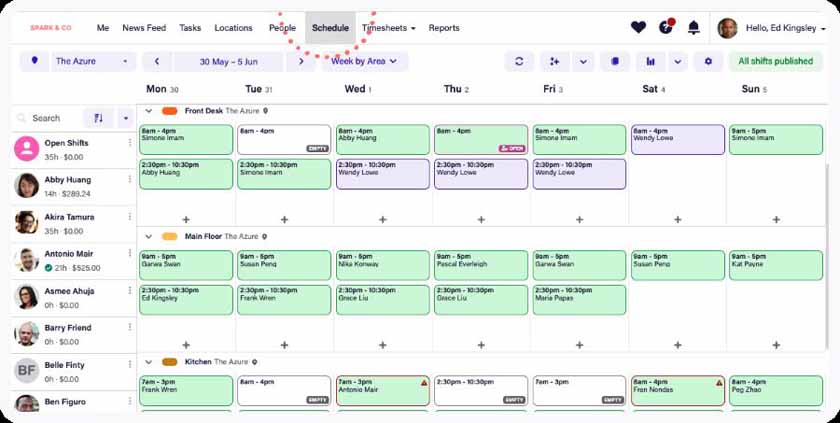
Deputy‘s interface makes it easy to get to schedules, tasks, reports, and more. (Source: Deputy)
7shifts: Best for Restaurants

Pros
- Intuitive interface
- Machine learning auto-scheduler tool
- Robust reports and POS integration options
- Free plan for single-location businesses with up to 30 employees
Cons
- Free plan with limited integrations and live support days (only for the first 60 days; but chat assistance is included in all plans)
- Advanced scheduling tools (like custom templates and autoscheduling) reserved for higher tiers
- Starter paid plan limited to 30 employees
Overview
Who should use it:
7shifts is designed specifically for restaurants, especially those with multiple locations. It’s one of our top restaurant scheduling software and, like some of the When I Work competitors in this guide, offers functionalities that allow you to plan work shifts, track employee attendance, and pay workers.
Why we like it:
You can use 7shifts for rules-based scheduling, maintaining manager logbooks, sending group communications, and shift swapping. Like Deputy, it has features for setting work-hour limitations for employees, which helps you avoid worker fatigue.
Unlike When I Work, it offers a free plan and by-location pricing, which can make it cheaper if you have plenty of employees. While it has an autoscheduler, like When I Work, and can integrate with a wide range of third-party payroll and time tracking systems, you have to subscribe to its higher tiers to access these functionalities.
- Free trial: 14 days
- Free plan:
- Comp: $0 for single-location businesses with up to 30 employees
- Paid plans:
- Entree: $34.99 per location, per month for up to 30 employees ($29.99 per location, per month if billed annually*)
- The Works: $76.99 per location, per month for unlimited employees ($69.99 per location, per month if billed annually*)
- Gourmet: $150 per location, per month for unlimited employees ($135 per location, per month if billed annually*)
- Monthly minimum spend: None
- Add-on tools:
- Payroll: $39.99 base fee + $6 per employee, per month
- Tip pooling: Starts at $24.99 per location, per month
- Tip payouts: $49.99 per location, per month + 75 cents per transaction; includes instant tip payouts to employee debit accounts
- Operations overview: $6.99 per location, per month; this lets you track labor performance and workforce engagement across all locations
- Manager logbook: $14.99 per location, per month: includes a customizable digital logbook to keep your managers in sync across shifts
- Task management: $12.99 per location, per month
- Employee onboarding: $2.99 per onboarding package sent
*Annual plans require a lump sum and upfront payment of all fees.
- Smart employee scheduling: Its machine-learning employee scheduling tool automatically creates work shifts based on your business’ workforce demands, labor cost and sales forecasts, and overtime compliance requirements, including your employees’ skills, schedule availability, and approved PTO.
- Restaurant-friendly tools: In addition to tip reporting, 7shifts has real-time labor reports and restaurant performance dashboards that provide a bird’s-eye view of your entire business operations, including how all your restaurants are performing and which locations may need extra attention. Other software in this list lack this type or level of detail in reporting.
- Robust integrations: 7shifts integrates with over 50 third-party software, including more than 20 POS solutions like Aloha, Micros, Dinerware, Square POS, Revel Systems, POSitouch, Squirrel Systems, and Heartland Restaurant POS. This puts it ahead of all on our list.
- Compliance tools: Along with audit logs, automated alerts, break and overtime settings, and early clock-in prevention, 7shifts can also help you avoid assigning “clopen” shifts. This ensures that employees get ample rest between schedules instead of working a closing shift and then an opening shift immediately the following day.
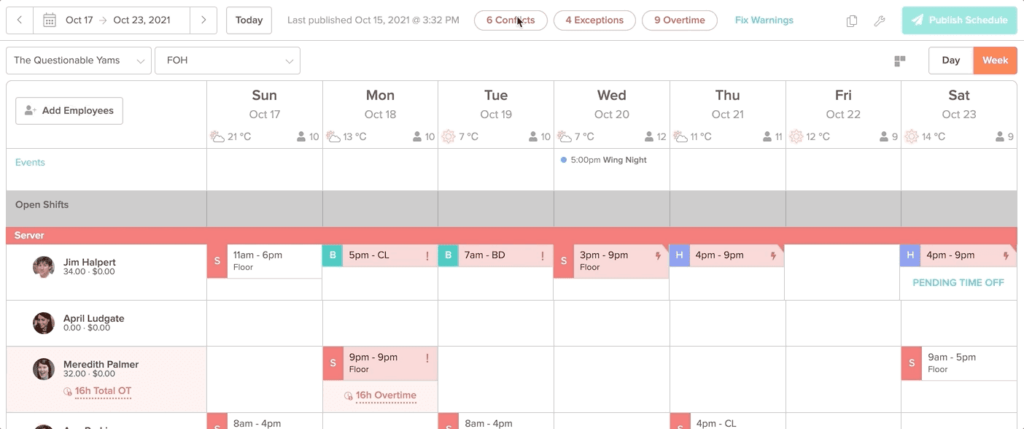
7shifts highlights schedule conflicts and labor warnings associated with a shift. (Source: 7shifts)
Sling: Best Budget-friendly Alternative

Pros
- Easy to use
- Free plan
- Unlimited locations and employees per plan
- Labor costing and forecasting included
Cons
- Autoscheduling in highest plan only
- No forecasting tools
- Free version does not include a time clock
Overview
Who should use it:
Budget-constrained small businesses with simple scheduling needs can save a lot with Sling. Its free plan covers up to 50 employees—larger than Homebase and 7shift’s free plan limits of 20 and 30 workers, respectively.
Why we like it:
Sling is a scheduling and time clock software with strong communication and tasking features. It’s the least expensive on our list of top When I Work competitors when you consider per-person costs. Its starter paid plan, which includes both scheduling and time tracking tools, is also slightly cheaper than When I Work’s basic tier with the time and attendance add-on ($2 vs $3 per employee, per month).
However, it doesn’t have the additional hiring and onboarding features that Homebase, Deputy, and 7shifts offer. Additionally, unlike When I Work, Homebase, and 7shifts which have payroll add-on products, you have to invest in a separate pay processing software to pay employees.
- Free trial: 15 days
- Free plan: $0 for up to 50 employees
- Paid plans:
- Premium: $2 per employee, per month ($1.70 per employee, per month if billed annually*)
- Business: $4 per employee, per month ($3.40 per employee, per month if billed annually*)
- Monthly minimum spend: None
- Add-on tools: None
*Annual plans require a lump sum and upfront payment of all fees.
- Task features: Openings, closings, deep cleans, and inspection preps all work better when the staff knows exactly what to do. Just like When I Work, Sling offers a robust tasking function that lets you assign tasks to individuals or teams, create and save task templates for recurring duties, and provide manager feedback.
- Scheduling: You’ll find most of the tools on Sling in other providers in this guide, but I especially liked how easily it tracked unavailability and time off because you can use it for compliance as well, like making school hours unavailable for your employees who are minors. The time clock lets you set limits on when early employees can clock in and will automatically clock them out at the end of the shift.
- Employee communications: Like Deputy and 7shifts, Sling offers both messaging and an interactive news feed, so you can keep your employees up to date on the latest news, whether it’s a new policy or a reminder. Employees can use the app to request shift swaps and get reminders about shifts and clocking in. The app’s rating is slightly lower than When I Work’s, however. It earned scores of 4.7 out of 5 on both the App Store and Google Play, while When I Work’s app received ratings of 4.8 out of 5 on the App Store and 4.7 out of 5 on Google Play.
- HR and payroll functions and integrations: It’s easy to tackle payroll by approving timesheets on desktop or mobile and exporting them to your third-party payroll processor or as an XLS or CSV file. Like When I Work, it integrates with popular restaurant POS systems like Toast, Square, and Restaurant Manager, as well as Gusto for payroll. However, the number of options isn’t as wide as 7shifts, which can connect with over 50 business software.
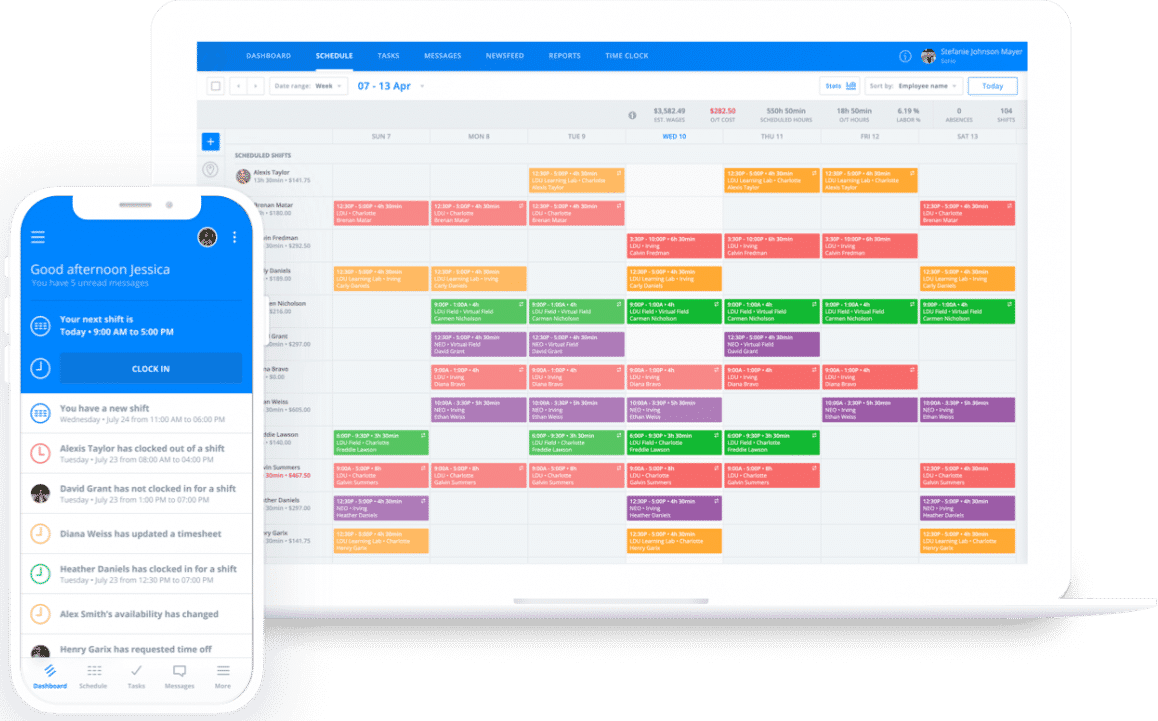
Sling offers easy-to-use scheduling for desktop and mobile. (Source: Sling)
SocialSchedules: Best for Companies in Highly Regulated Industries

Pros
- User-friendly with a simple and visually appealing interface
- Robust compliance tools
- Basic scheduling, time tracking, time-off management, and communication tools included in its free tier
- Able to track worker certifications for schedule enforcement and time tracking
Cons
- Only 10 scheduled workers, one department in one location, and cloud storage for 28 days covered in the free plan
- Advanced features like multilocation scheduling and compliance rule sets included in paid plans; dedicated customer support reserved for the highest tier
- Glitchy mobile app; desktop and mobile apps don’t always sync properly
Overview
Who should use it:
SocialSchedules is a great When I Work alternative if you have jobs that depend on certifications or you are in a high-compliance industry. While you need at least the Premium plan, the certification management tools are excellent, allowing you to enforce planned shifts and prevent clock-ins if the required training or work certifications are not completed.
Why we like it:
SocialSchedules allows you to create compliance rules that will guide your scheduling options and help you avoid penalties. It sends notifications and mobile alerts for overtime and breaks that don’t comply with state and local labor laws and allows you to store schedule histories and reports for up to seven years.
Unlike When I Work, it has a free plan with basic scheduling and time tracking features. However, it only covers up to 10 scheduled workers. Consider Sling if you want a free plan with a bigger employee limit (it covers up to 50 workers).
- Free trial: 14 days
- Free plan:
- Basic: $0 for 10 scheduled workers and one department in one location + 28 days of cloud and reporting data storage
- Paid plans:
- Starter: $15.99 per location, per month ($12.99 per location, per month if billed annually*)
- Premium: $39.99 per location, per month ($33.99 per location, per month if billed annually*)
- Enterprise: Call for a quote
- Monthly minimum spend: None
- Add-on tools: None
*Annual plans require a lump sum and upfront payment of all fees.
- Shift management: SocialSchedules lets your employees drop shifts (along with requesting shift swaps) if they need to. However, your managers can lock important workdays to prevent schedules from being swapped and dropped.
- Labor laws compliance: SocialSchedules automatically allocates paid/unpaid breaks based on actual worked hours, applies penalties for missed meal breaks, and stops the send-outs of schedules with compliance breaches. It also provides cloud storage for edit histories and reports for up to seven years. Only SocialSchedules allows you to add certification-related scheduling and time-tracking rules, enabling you to enforce work shifts that require employees with specific certifications.
- Multiple employee availability sets: SocialSchedules allows your employees to create multiple availability sets that show when they are available and unavailable to work. Each set contains start and end dates and can be repeated on a weekly or biweekly basis.
- Certification management: While available only in its higher tiers, this helps you track the training sessions that employees must attend and the expiration dates of certification programs (if applicable). When I Work lacks this.
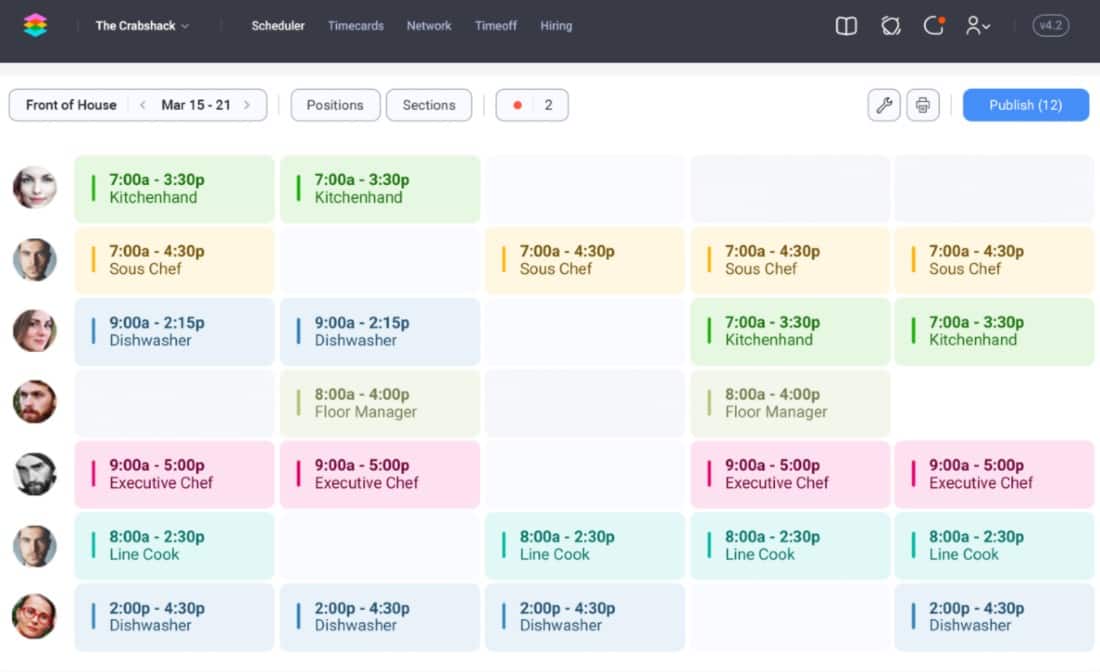
SocialSchedules has shift templates and locked days. (Source: SocialSchedules)
ZoomShift: Best for Seasonal Businesses

Pros
- Able to sync with other calendar apps
- Easy to use
- Able to put plans on hold in off-seasons
Cons
- Free plan limited to 20 employees
- Limited integrations
- Slow loading of mobile app at times
Overview
Who should use it:
ZoomShift is a scheduling and time tracking software that is great for small businesses in the agricultural, construction, and tourist industries, which have seasonal highs and lows. It allows you to plan shifts for weeks or months ahead to make sure you have everything covered during peak or low seasons.
Why we like it:
ZoomShift lets you pause your subscription while retaining your data. If you have a seasonal business, this feature lets you stop and start your subscription without having to input your employee data and previously created schedule templates again. Like Sling, Zoomshift’s basic paid plan is slightly cheaper than When I Work’s starter package with the time-keeping add-on. You’ll only be charged $2.50 per employee, per month; whereas When I Work will bill you $3 per employee, per month for the said tier.
However, ZoomShift’s basic paid plan doesn’t include schedule templates. It also lacks autoscheduling, which When I Work and most of the providers on our list have.
- Free trial: 14 days
- Free plan:
- Essentials: $0 for up to 20 employees
- Paid plans:
- Starter: $2.50 per employee, per month ($2 per employee, per month if billed annually*)
- Premium: $5 per employee, per month ($4 per employee, per month if billed annually*)
- Monthly minimum spend: None
- Add-on tools: None
*Annual plans require a lump sum and upfront payment of all fees.
- Seasonal features: The seasonal planning and ease of use make it a good choice for staff that only works at certain times of the year, like the college student who serves tables over the summer. If you close down for parts of the year, ZoomShift lets you pause your account while retaining your information.
- Scheduling: Of all those on our list, ZoomShift is the most basic. You can copy schedules or save schedules as a template, as many as you like. Employees can raise swap shift requests via computers and ZoomShift’s mobile app. You can also sync the schedule with Google Calendar, iCal, and Outlook.
- Time tracking: The time tracker is integrated, making managing time sheets and tracking employee hours easy. You can track missed shifts, late arrivals, and more. You can set rules to restrict hours or for geofencing and get alerts when an employee is approaching overtime. In addition, you can approve time sheets and create payroll reports, which you can download as CSV or XLS for putting into a payroll program.
- Employee communications: Like other providers in this list (including When I Work), ZoomShift lets you offer open shifts and allows employees to trade shifts. It alerts managers about overtime and breaks of shift rules (like clocking in early) and has event announcements, group chats, and direct messages.
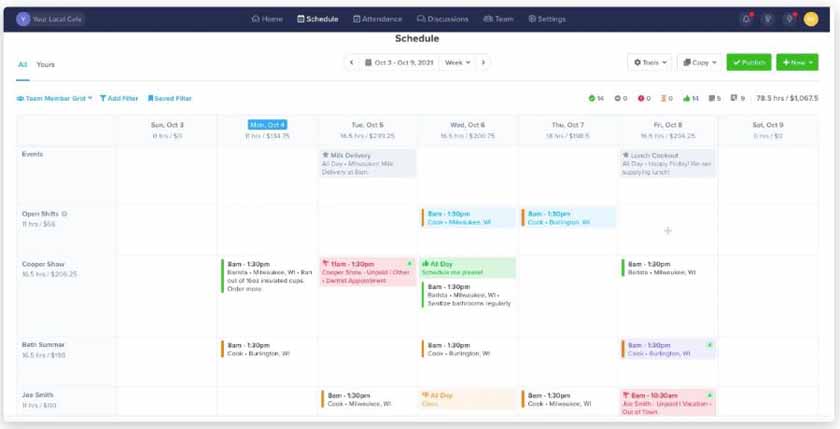
ZoomShift has a simple interface. (Source: ZoomShift)
When to Consider When I Work
When I Work is a very popular scheduling software. Its basic plan is for scheduling only and is among the least expensive on the market (priced at $1.50 per employee, per month)—but it costs more when you add a time clock ($3 per employee, per month). Users find it easy to use and rate it 4.4 out of 5, averaged over multiple user-review sites (such as G2 and Capterra). Its forecasting and autoscheduling tools are available in all plans. This is unlike the other providers in this guide, which offer these functionalities in higher tiers.
The mobile app has excellent ratings, with GPS tracking, shift swapping, time off requests, and more. Managers can even text employees when contacting them via the app is not enough. Managers can see who looked at their schedule as well.
One standout, which we did not find in any When I Work competitor, is the capability to pay employees immediately. On-Demand Pay by Clair lets you give employees a Clair debit card to send pay immediately. Most companies need payroll software for this functionality.
For other When I Work pros and cons, check out the box below.

Pros
- Autoscheduling and forecasting in all plans
- Intuitive interface and highly rated mobile app
- Unique on-demand pay option
Cons
- Time clock costs extra
- No free plan
- Does not let you record time per project
Pricing
- Free trial: 14 days
- Free plan: None
- Paid plans:
- Essentials: $1.50 per employee, per month ($3 per employee, per month if with the time tracking add-on)
- Pro: $3 per employee, per month ($5 per employee, per month if with the time tracking add-on)
- Premium: $5 per employee, per month ($7 per employee, per month if with the time tracking add-on)
- Monthly minimum spend: None
- Add-on tools:
- Payroll: $39 based fee + $6 per employee, per month; requires the time tracking module
How to Choose the Best When I Work Alternative
In selecting the right scheduling software or When I Work alternative for your business, consider the following factors:
- Size of your business and workforce: Check if the provider charges monthly fees by employee count or business location. If you have multiple locations, software with per-location pricing will save you more money as it usually covers unlimited employees.
- Your budget: Scheduling systems usually cost anywhere from $1.50 to $10 per user monthly. However, if you have a small team, look for When I Work competitors that offer free plans. This option typically grants you access to basic scheduling features, allowing you to plan work shifts at zero cost.
- Features: Make a list of the functionalities that you need. Some of the essentials include schedule builders, shift swapping, staff availability management, automated reminders, reporting tools, and compliance solutions for planning breaks and overtime.
- Ease of use: Take advantage of free trial offers as these allow you to check how easy (or difficult) it is to navigate through its features. You should also look for automation tools, which can save you time and simplify processes once they are set up.
- Integration options: If you use business software, such as payroll and time tracking tools, check whether the scheduling software connects with these systems. The integration helps ensure easy data transfers between solutions, such as exporting your planned shifts to your time tracking tool for attendance tracking.
- Customer support: Having access to live phone support is ideal. You should also check user reviews on popular review sites (like G2 and Capterra) to help you gauge if the provider offers good customer service.
Methodology: How We Evaluated the Top When I Work Competitors
In evaluating the best When I Work alternatives for small businesses, we used our employee scheduling software rubric, wherein we compared 19 solutions (excluding When I Work) and narrowed the list down to six options. We looked at pricing, ease of use, user reviews, and customer support. Then, we checked if the software has similar functionalities to When I Work but offered something more or different to address specific needs.
To view our full evaluation criteria, click through the tabs in the box below.
30% of Overall Score
Aside from looking at whether the provider has a free plan and affordable pricing for its paid plans ($5 or less per employee, per month), we checked if its scheduling solution can be accessed or purchased separately from the provider’s other software products.
25% of Overall Score
The best scheduling software includes at least basic tools, such as shift swapping, schedule alerts, and overtime, break, and paid time off planning. Plus, having access to team messaging, multilocation scheduling, mobile apps, and a self-service portal is also ideal.
25% of Overall Score
Having an employee scheduling platform that’s intuitive and easy to learn is a must. We looked at whether the provider offers live phone support, new client training, software integration options, and an in-house time and attendance module that syncs directly with its scheduling tool.
10% of Overall Score
In addition to having access to standard and prebuilt reports, users should be able to customize reports.
10% of Overall Score
We checked reviews that actual users left on third-party sites like G2 and Capterra. Providers that received more than a 4-star rating and had fewer complaints got a higher score.
When I Work Alternatives Frequently Asked Questions (FAQs)
Perhaps not. If you have very simple needs, you can get by with Excel sheets. However, a scheduling software provides you with an easier way to manage work shifts. Most offer schedule templates, automated alerts, and a schedule builder that allows you to assign shifts by dragging and dropping work schedules to specific employees.
Yes, there are! Some good options are included in this guide, such as Homebase, Deputy, Sling, 7shifts, ZoomShift, and SocialSchedules. Don’t forget to check if these free options have limits, such as a specific employee count.
Scheduling software is for creating and filling shifts and may include shift swaps, tasks, and time off management. Meanwhile, time tracking software involves clocking in and out for the shifts—although it, too, may include shift communication skills.
Bottom Line
When I Work is a great tool for managers and business owners to make employee scheduling fast and easy. However, it may not meet all your needs, whether for budget or tools. The When I Work competitors on our list fill different use cases so that you can pick the best option for your business.
Overall, however, we found Homebase to be the best alternative as it has robust time tracking and employee scheduling features like When I Work, but also offers an excellent free plan. Its per-location pricing may also benefit growing or large businesses. So if you are looking for a different choice from When I Work that covers the basics and more, give Homebase a try.